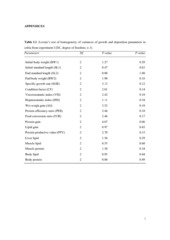| dc.description.abstract | Aquaculture of cobia, Rachycentron canadum is hampered by lack of good feeding protocols and nutritionally optimized diets. Studies on the role of appetite and feeding behavior regulating neuropeptides in cobia have not been pursued to date. The current study initially assessed the impact of plant-based protein diets with different lysine (L) to arginine (A) ratios on appetite and feed intake, feed efficiencies, growth performance, and the deposition of protein and lipid in juvenile cobia. In addition, this study also aimed to determine whether there is a link between the dietary ratio of lysine to arginine, feed consumption, and expression of cobia brain neuropeptides (npy and cck). In a pilot experiment, juvenile cobia were fed to satiety with two commercial diets (CD1 and CD2) or the plant-based protein test diet with balanced lysine to arginine ratio (1.1; BL/A) had equal feeding rate of 5.3-5.4±0.3% BW (for a meal). No differences in stomach filling occurred between cobia fed the test diet and the two commercial diets. Gastric evacuation rates in cobia were performed as an exponential relationship, and were estimated as the function YT=V0 e-b(x) (VT, volume of feed at time T; V0, volume of feed at time 0; b, the instantaneous evacuation rate; and x, time postprandial; R2>0.95). Between 77 to 80% of the stomach contents were evacuated to the lower parts of the gastrointestinal tract at 8 h, and most of consumed feed (98%) was emptied out of the stomach at 16 h postprandial. In experiment I, juvenile cobia fed with two commercial diets (CD1 and CD2) and the BL/A diet (for 4 weeks) grew as well as one of the commercial diet, but better than the other. However, cobia fed the CD2 diet deposited more lipid than cobia fed the BL/A diet. Cobia fed the BL/A diet obtained better weight gain, feed conversion ratio and protein gain than cobia fed the commercial diet CD1, while lipid gain was less in fish fed the BL/A diet. No differences in plasma amino acid profile analyzed at 24 h postprandial were observed between cobia fed any of the three diets. Thus, juvenile cobia had the ability to grow and utilize the plant-based protein diet and these two commercial diets. In experiment II, juvenile cobia were fed to satiety with three test diets of plant-based protein and different lysine to arginine ratio (0.8, LL/A; 1.1, BL/A; and 1.8, HL/A) diets and the CD2 diet as a control for growth for 6 weeks. Similar growth performance was found for the balanced lysine to arginine ratio diet, but imbalanced lysine to arginine ratio reduced performance. In experiment III, juvenile cobia were fed to satiety with the LL/A-, BL/A- and HL/A diet, using the CD2 diet as control for 6 weeks. Periprandial expression of brain mRNA for NPY and CCK (npy and cck) were measured twice, at weeks 1 and 6. Feed intake and growth performance were also recorded. At week one, levels of expressed brain npy were significantly higher in pre-feeding cobia (unfed) than fed cobia, except in the fish fed the LL/A diet. At week six, expression of brain npy in unfed cobia was significantly higher than in fed cobia for all diets. For brain cck, there were no significant differences in expression, regardless of feeding status (pre-feeding or after a meal with any of the diets) or time point. This indicates that NPY serves as an orexigenic factor in cobia. No clear correlations between the dietary lysine to arginine ratios and feed intake, growth and expression of npy and cck was found. Cobia fed the LL/A diet had lower feed intake than those fed the BL/A- and control diet, while cobia fed both imbalanced diets (LL/A and HL/A) had reduced growth, compared to cobia fed the BL/A- and control diet. This suggests the existence of a mechanism that links dietary lysine and/or arginine to regulation of appetite and feed intake in cobia. In conclusion, cobia grew and utilized the diet with high plant ingredient inclusion. Imbalanced dietary lysine to arginine ratios negatively affected feed intake and feed efficiencies, thus reduced growth. Brain npy levels in fed cobia were significantly lower than that in pre-feeding cobia, suggesting that NPY is an orexigenic factor in cobia. Dietary lysine to arginine affected the expression of npy at short-term feeding, but not at long-term feeding, suggested that feeding-regulating adaptation may exist in cobia. Meanwhile, brain cck levels in unfed cobia did not differ from that in fed cobia, regardless of dietary lysine to arginine ratios or time point in the current study. | en_US |
| dc.relation.haspart | Paper I: Nguyen, M. V., Rønnestad, I., Buttle, L., Lai, H. V. and Espe, M. Evaluation of a high plant protein test diet for juvenile cobia (Rachycentron canadum) shows growth comparable to commercial diets. Full text not available in BORA. | en_US |
| dc.relation.haspart | Paper II: Nguyen, M. V., Rønnestad, I., Buttle, L., Lai, H. V. and Espe, M. Imbalanced lysine to arginine ratios reduced performance in juvenile cobia (Rachycentron canadum) fed high plant protein diets. Full text not available in BORA. | en_US |
| dc.relation.haspart | Paper III: Nguyen, M. V., Olderbakk J. A-E., Espe, M., Buttle, L., Lai, H. V. and Rønnestad, I. Feed intake and brain neuropeptide Y (NPY) and cholecystokinin (CCK) gene expression in juvenile cobia fed plant-based protein diets with different lysine to arginine ratios. Full text not available in BORA. | en_US |

